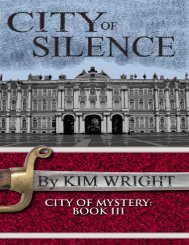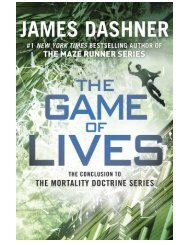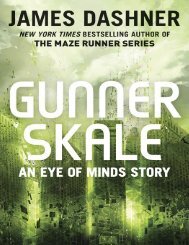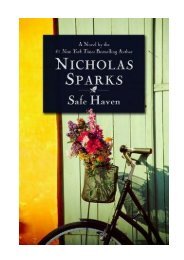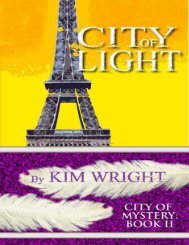32896589326509350
Create successful ePaper yourself
Turn your PDF publications into a flip-book with our unique Google optimized e-Paper software.
come to enjoy their internal music and may feel it as an enrichment of life. Ivy L., a<br />
lively and articulate eighty-ve-year-old, has had some visual hallucinations related to<br />
her macular degeneration, and some musical and auditory hallucinations stemming from<br />
her hearing impairment. Mrs. L. wrote to me:<br />
In 2008 my doctor prescribed paroxetine for what she called depression and I called<br />
sadness. I had moved from St. Louis to Massachusetts after my husband died. A<br />
week after starting paroxetine, while watching the Olympics, I was surprised to<br />
hear languid music with the men’s swim races. When I turned o the TV, the music<br />
continued and has been present virtually every waking minute since.<br />
When the music began, a doctor gave me Zyprexa as a possible aid. That brought<br />
a visual hallucination of a murky, bubbling brown ceiling at night. A second<br />
prescription gave me hallucinations of lovely, transparent tropical plants growing<br />
in my bathroom. So I quit taking these prescriptions and the visual hallucinations<br />
ceased. The music continued.<br />
I do not simply “recall” these songs. The music playing in the house is as loud<br />
and clear as any CD or concert. The volume increases in a large space such as a<br />
supermarket. The music has no singers or words. I have never heard “voices” but<br />
once heard my name called urgently, while I was dozing.<br />
There was a short time when I “heard” doorbells, phones, and alarm clocks ring<br />
although none were ringing. I no longer experience these. In addition to music, at<br />
times I hear katydids, sparrows, or the sound of a large truck idling at my right<br />
side.<br />
During all these experiences, I am fully aware that they are not real. I continue<br />
to function, managing my accounts and nances, moving my residence, taking care<br />
of my household. I speak coherently while experiencing these aural and visual<br />
disturbances. My memory is quite accurate, except for the occasional misplaced<br />
paper.<br />
I can “enter” a melody I think of or have one triggered by a phrase, but I cannot<br />
stop the aural hallucinations. So I cannot stop the “piano” in the coat closet, the<br />
“clarinet” in the living room ceiling, the endless “God Bless America”s, or waking<br />
up to “Good Night, Irene.” But I manage.<br />
P<br />
ET and fMRI scanning have shown that musical hallucination, like actual musical<br />
perception, is associated with the activation of an extensive network involving many<br />
areas of the brain—auditory areas, motor cortex, visual areas, basal ganglia,<br />
cerebellum, hippocampi, and amygdala. (Music calls upon many more areas of the brain<br />
than any other activity—one reason why music therapy is useful for such a wide variety<br />
of conditions.) This musical network can be stimulated directly, on occasion, as by a<br />
focal epilepsy, a fever, or delirium, but what seems to occur in most cases of musical<br />
hallucinations is a release of activity in the musical network when normally operative<br />
inhibitions or constraints are weakened. The commonest cause of such a release is







